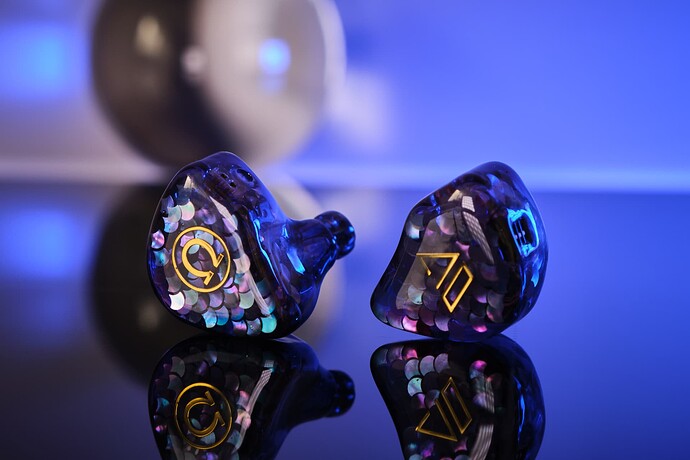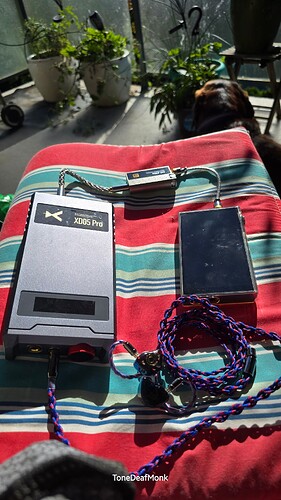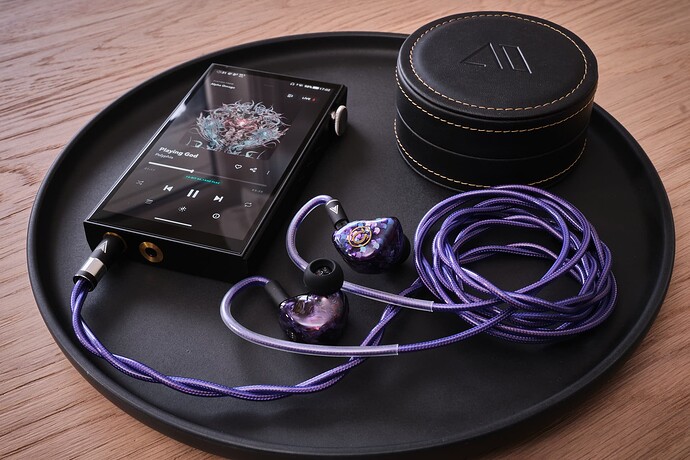For the Ultimate was DC Elite as DAC out to XDUOO XD05 Pro for amp. My desktop stack a clise second with the Geshelli Labs J2 DAC and Topping A90D Amp
Omega is so epic, should try and finish my review next week now that I got it back. It’s not all about bass, but wow this bass is best quality I have heard ![]()
Finished my review today on the Omega, flagship sound that’s dynamic and fun.
- Bass is among the best out there in quality
- Smooth and full sounding timbre
- Ethereal EST highs
- Rich midrange
Kevin Davies - Review of the OMEGA
Alpha Omega - Omega
1 x 10mm Dynamic Driver
4 x Sonion Ba Drivers
4 x Sonion Electrostatic Drivers
6-way Passive Crossover
1 Dynamic Driver for Subbass
1 Sonion BA for Bass
1 Sonion BA for Low Mid
2 Sonion BA for Mid and High Mid
2 Electrostatic Drivers for High
2 Electrostatic Drivers for Ultra High
Sincere and gracious thanks go out to Tone Deaf Monk for the loan of the Alpha-Omega, Omega from his private reserve. ![]()
![]()
** Note: I received the IEM and carry case only, so I can’t speak to the packaging or stock cable. I paired it with the DDHiFi Nyx Pro SPC cable with 4.4mm termination.
There is not much “about” info available for Alpha Omega.
What I do know is they are an independent boutique IEM developer and manufacture based in Malaysia.
The creative mastermind and driving force behind Alpha Omega is a gentleman named Clement.
They have two current IEM models, the RA, and their recently released flagship model the Omega.
Pros:
![]() Stunning shell design and build quality. Shells are on the larger size, but very reasonable considering the driver complement. Nozzle length and angle are perfect for me. Secure seal and anchor at mid point depth.
Stunning shell design and build quality. Shells are on the larger size, but very reasonable considering the driver complement. Nozzle length and angle are perfect for me. Secure seal and anchor at mid point depth.
![]() 3 Tuning switches for Bass, Mids, Treble boost. Switches are very well implemented.
3 Tuning switches for Bass, Mids, Treble boost. Switches are very well implemented.
![]() Follows source device tuning.
Follows source device tuning.
![]() Follows recorded source. Quality recorded sources shine. Less refined recorded sources, rather than being completely laid bare, sound as good as possible
Follows recorded source. Quality recorded sources shine. Less refined recorded sources, rather than being completely laid bare, sound as good as possible
![]() Excellent bass structure with good definition between sub and mid bass.
Excellent bass structure with good definition between sub and mid bass.
![]() Highly detailed mids.
Highly detailed mids.
![]() Clean, tonally accurate vocals.
Clean, tonally accurate vocals.
![]() Good micro details in the highs, and airy, detailed, accurate ultra highs.
Good micro details in the highs, and airy, detailed, accurate ultra highs.
![]() Staging is more “intimate night club” than “expansive stadium” but it fully fills the head space. Layering is excellent and imaging is precise and accurate.
Staging is more “intimate night club” than “expansive stadium” but it fully fills the head space. Layering is excellent and imaging is precise and accurate.
Cons:
![]() Price. At $2700 usd. It stands to reason many enthusiasts won’t enjoy the opportunity to hear this IEM.
Price. At $2700 usd. It stands to reason many enthusiasts won’t enjoy the opportunity to hear this IEM.
![]() Tuning Switches:
Tuning Switches:
The three tuning switches are straight forward, they are boost on, or boost off.
Switch one Bass.
Switch two Mids and Vocals.
Switch three Treble.
I started with all three off and then turned each one on in succession at intervals as I brain burned to each change.
Each switch adds a very noticeable boost to the respective frequency, but without taking any frequency range to extremes. Very nice implementation.
With all three switches turned on the music is full and rich with lots of note weight and body.
I’m somewhat mids sensitive and found the mids just a touch too forward and energetic on occasional tracks with all three in the on position.
Just enough that it would intermittently pull me out of my music drift and disrupt my listening experience.
My final switch setting preference was
1 on, 2 off, 3 on.
2 off reduced the mids energy nicely, albeit at the expense of a small amount of mids/vocal energy and stage height.
![]() Source Devices:
Source Devices:
I tried Omega with pretty much every source device I own.
I found a warmer source device was my preference for casual listening.
Less technical precision, but really easy to slip into the music and coast along for the ride for hours at a time.
Brighter more resolving source devices brought the Omega’s technical abilities to the forefront. Still a very enjoyable listening experience, but with my attention drawn more to the technical precision of the recorded source, rather than relaxed and just drifting along.
The Shanling M9 Ltd. and Astell & Kern SP2000T on tube amp mode were the two sources I chose most often.
![]() Equipment:
Equipment:
![]() Alpha Omega - Omega IEM with 100+ hours. Bass boost switch on, Mids switch off, Treble switch on.
Alpha Omega - Omega IEM with 100+ hours. Bass boost switch on, Mids switch off, Treble switch on.
![]() DDHiFi Nyx Pro silver plated copper, shielded cable, terminated 4.4mm.
DDHiFi Nyx Pro silver plated copper, shielded cable, terminated 4.4mm.
![]() Dunu SS ear tips.
Dunu SS ear tips.
![]() Shanling M9 Ltd DAP, low gain, 4.4 balanced out.
Shanling M9 Ltd DAP, low gain, 4.4 balanced out.
![]() A&K SP2000T DAP, tube amp mode, 4.4 balanced out.
A&K SP2000T DAP, tube amp mode, 4.4 balanced out.
![]() Sound:
Sound:
Omega has excellent bass structure.
Especially on more resolving source devices. Bass is tighter and has very well defined sub/mid bass separation. Bass has a strong presence, but well managed, and stays in place.
On warmer sources the sub bass gains extra presence and the sub/mid bass presence becomes somewhat less defined. A touch more carry over adds warmth to the mids.
Lower mids are recessed, upper mids recover nicely and have very good detail, clarity, and separation.
On warmer source, a small amount of detail is sacrificed for a warmer presence with more note weight.
Vocals, both male and female, have natural and accurate tonality.
They don’t present overly elevated in the head space. (I have mids/vocal boost switch off)
Warmer source device adds some warmth and weight to vocal presence.
Highs are carried mostly by the upper mids. Micro detail retrieval is somewhat limited in the treble region.
There is a peak at 8k, the e-stat drivers are exceptionally well tuned, and add sparkle, air, and some micro detail to the upper end.
Staging is very good and fills the head space.
Good “outside the head” width and stereo imaging left to right.
Good height top to bottom. (Adding mid boost with switch 2 adds height to mids and vocals)
Depth front to rear is very good but track dependent.
Layering and imaging is precise and accurate.
![]() Summary:
Summary:
The Omega is a Megabuck IEM and anything short of incredible would be a disappointment. Omega does not disappoint.
It’s one of those IEM’s that draws you into your music library, and you don’t want to leave. “Just one more song”.
The presentation is fairly balanced with a mids/vocals lift, and very much musical.
I put Omega up against a couple of my long time favourites, the FatFreq Grand Maestro, and Kinera Loki.
And while Omega didn’t outright dethrone either of these IEM, it easily earned itself a seat at the same table.
And, it is priced somewhat less than its above noted competitors.
Some brief comparisons are posted below.
![]() My Music Sources:
My Music Sources:
Qobuz, and, FLAC and DSD files stored on the SD cards of my daps.
My music genre are primarily Rock, Blues, Jazz, Symphonic, Country, Rap, R&B, Pop, Electronic.
Comparisons:
100% biased to my physical hearing properties, and hearing preferences.
Then again, so is every review. ![]()
![]() Frat Freq Grand Maestro CIEM.
Frat Freq Grand Maestro CIEM.
$2950 - 3300 usd (cable choice)
1 DD, 8 BA, 4 EST
Black NOAH module, Vocal switch on, Stock, upgraded gold plated cable.
GM shares a similar bass structure with Omega, both have strong bass presence with good separation and definition between sub and mid bass.
GM leans a touch more to sub bass with a little more rumble. Omega a bit tighter and smoother, and, a little more mid bass present.
Mids and vocals are more forward and elevated on GM, Keep in mind I have mids/vocal boost turned off on Omega and turned on for GM, but GM doesn’t violate my mids sensitivities with the extra boost active.
Both have highs carried more by the upper mids, and both have well implemented EST drivers adding air and sparkle to the upper end.
Pretty much have to say it’s a push on the top end between these two.
Staging is good on both, but, the GM has the edge over Omega with a more spacious stage and better separation between instruments.
Omega however has a more refined and “integrated” stage presentation.
I like both, and this would come down to personal preference.
![]() Kinera LOKI UIEM
Kinera LOKI UIEM
$3100 usd
1 DD, 6 BA, 4 EST, 1 BC
No tuning switches or modules.
Stock, Effect Audio pure copper cable.
Bass on the Loki also has excellent bass structure, with very good sub/mid bass definition.
FR graph would suggest the Loki has the lowest bass shelf of the three IEM but, Bone Conduction drivers don’t register on frequency graphs.
The BC drivers add a visceral element to the bass, especially on sub bass heavy tracks which have an actual tactile feel to the bass.
The sub bass pulls lower than both the Omega and Grand Maestro, but as for overall quality, it’s splitting hairs between the three.
Mids on the Loki are open and spacious, and, more detailed than both Omega and GM.
Vocals are also more elevated and forward, without being harsh or shouty. (keeping in mind I am listening to these IEM tuned to my personal preference, and I have the mids dialled back on both Omega and GM via switches and modules)
Loki has more treble energy and a touch micro detail retrieval in the treble region.
But I have to give the win to Omega and GM for EST implementation and air and sparkle in the upper end.
Nothing wrong with Loki, but Omega and GM have a touch more sizzle.
Staging goes to Loki, hands down.
Loki has the most expansive, holographic stage I have heard to date in an IEM. And on tracks that deliver, the imaging and layering on all three axis is unmatched by anything I have had the privilege to listen to, as yet.
Enjoy your music. ![]()
![]()
Hi, Thanks for the detailed review! The Omega sounds impressive. I’ve heard great things about the FatFreq Grand Maestro too—how do you think the two compare in terms of overall soundstage and detail?
How does the Origin compare to it?
A bit late to the party but here’s my review of the Alpha Omega Ra. I figured that some IEMs aren’t getting enough attention and I try to find and review them.
is Alpha Omega worth getting, if I have GM already?
Thanks
Alpha omega is interesting man, I enjoy the Ra so much wonder how much of an upgrade the Omega is.
Seems it’s tuning is on point but their customer service and quality control is Wack so buyer beware.
Edited…welcome to HFG’s ![]()
I would say no it would be a sidegrade it’s alot easier to dial in with the switches both are simply fantastic.
If you already have the GM, it’s a tough call—GM’s versatility and clarity might make it hard to top.
I had an issue with my Ra and messaged Clement, he was ready to help. In fact, he not only helped me with the repair but also sent back with customs pre-paid since they are an issue in my country. Yes took some time(about 3-4 weeks) but resolution was provided.
Although yes the service could have been faster.
I don’t consider 3-4 weeks for a positive outcome to be excessive in your case ![]() let’s see how things pan out for other folk that may have similar issues
let’s see how things pan out for other folk that may have similar issues ![]()
Yes, for those who aren’t reviewers. I don’t think we can ever discount preferential treatment, unless one can be certair that the retailer doesn’t know that they’re a reviewer.
Thanks!
Yea, I heard that Fatfreq got some QC issues for their deuce IEMs, other than that, is there anything that i don’t know about?
I’m from the same city as him though I’ve moved to Kuala Lumpur. I’ll have a chat with him next time I’m home.









